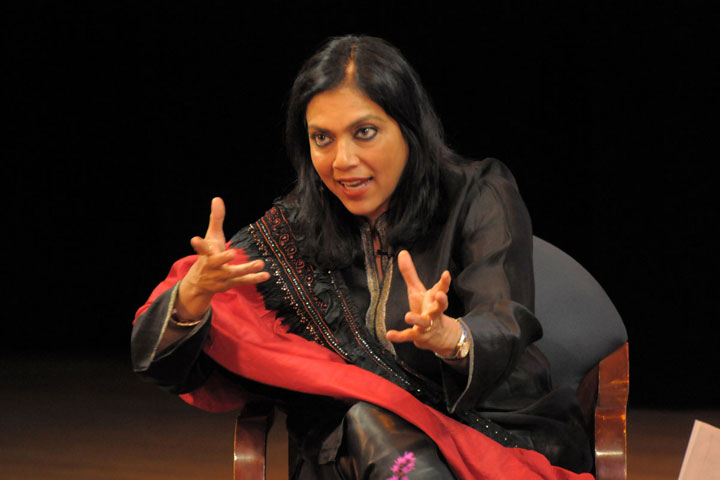"Gynocriticism is a way of assessing works of art specifically in relation to the interests and desires of women...it involves a separate female way of thinking and a recognition that women's experience has been effectively silenced by a masculine culture." (Author/Auteur)
Accomplished writer, director and produced Mira Nair is Indian born, Delhi University and Harvard educated. Unlike the film maker Marleen Gorris and many of the female directors examined in class material, Nair claims that she "fell into" directing. Having studied acting, she realized that she wanted autonomy and creative control in her artistic process. Throughout her career working on films such as Vanity Fair, The Namesake and the Amelia Earhart biopic, Amelia, Nair has always insisted on putting women at the centre of her films - despite working with big Hollywood studios.(Kahleeli) She is most notable for her award-winnning films Salaam Bombay! (1988) and Monsoon Wedding (2001, for which she was the first woman to be awarded the Gold Lion at the Venice Film Festival). With the exception of the Amelia (critical failure) her films have been well received.
"But if I have an obsession at all, it is with hands. I love hands and I love lips. I never cast lipless actors. So Kenneth Branagh, no thank you. It's a weird thing but I do have these two obsessions."
"I like to be unabashed, which is an Indian trait, both emotionally and visually. It's important to have a circus to play with." (from her IMDB page)
In reading some of her personal quotes about her work and filmmaking process, I was struck by how closely they parallel the consolidations of authorship chosen by feminist literary/film critics, as described in Author/Auteur: a double voice, marked intensity of camera identification, a lending of herself, the 'anxiety of authorship', and of recurring signatures/repetitive use of particular elements.
Nair said in an interview with the Guardian, that "Cinema, something I am afflicted by, is something that lends its beautiful voice to this phenomenon of being in many places at once. I have chosen a form, or a form has chosen me, that can represent that. It's something I understand very well. I always try to make films about things that get under my skin. "
As an auteur, Nair films from the perspective of the "other", often using the supporting characters in her films to manifest cultural and social traditions. As discussed in Movie Magic, "Movies remain the perfect vehicle for the introduction of certain rites of passage that come to stand for the quintessential experience of border crossing for everyone who wants to take a look at difference and the different without having to experientially engage with the 'other.'"She has said she is drawn to marginalized characters, "I want to question what the outside is and who defines it. I often find those that are considered to be on the outside extremely inspiring. They are the people who see through the double standards, like the kid in Salaam Bombay and the courtesan in Kama Sutra." (Guardian interview)The "other" she explores has taken the form of women, exiled or displaced people, and racially tender and nuanced subjects.
From her early documentary work about Indian cabaret workers, her re-imagining and re-framing of female sexuality in Kama Sutra: A Tale of Love, to the complex family and identity explored in Monsoon Wedding, Nair has traced and affirmed the more extensive features of female authorship: the vivification of anxieties of authorship in characters writers detest, an 'oddity' and 'eccentricity' of style, a revision of genres as well as linking aspects of female sexuality with textuality. (Author/Auteur) Exile, loss and longing are themes she explores, "I feel very much that cinema is born as a medium to capture exile. The idea of going out of your hotel in Mississippi and looking out of your window and seeing your garden in Kampala. This something that cinema lends itself to brilliantly, almost as much as literature." (Guardian interview)
Nair has said that Monsoon Wedding was her love letter to India, her version of a Bollywood film. In this age of mixing and hybridity, popular culture, particularly in the world of movies, constitutes a new frontier providing a sense of movement away from the familiar and journeying into and beyond the world of the other. (Movie Magic) It is a comedy-drama about a huge, over-the-top, traditional arranged marriage in contemporary, middle class India. In the film, there are layers of relationships between the central family members, and servant characters. Incest and abuse, infidelity and adultery, and ultimately love are explored. Monsoon Wedding staggeringly includes five plots lines, sixty-eight actors, three languages, cartloads of marigolds (inflection?), love, laughter, incest, sorrow, potentially gay sons and constantly ringing cell phones into one lush, mirthful and questioning film.
Mira Nair is currently an adjunct professor at Columbia University. Her production company is Mirabai Films.
Citations:
Author/Auteur:Feminist Literary Theory and Feminist Film
Introduction: Making Movie Magic
Kahleeli, Homa. "Top 100 Women: Art, Film, Music and Fashion." Guardian. 7 March 2011: n. page. Web. 2 May. 2012. <http://www.guardian.co.uk/culture/2011/mar/08/mira-nair-100-women>.
http://www.guardian.co.uk/film/2002/jun/12/guardianinterviewsatbfisouthbank1
Her IMDB page: http://www.imdb.com/name/nm0619762/bio

No comments:
Post a Comment